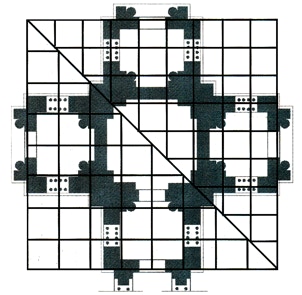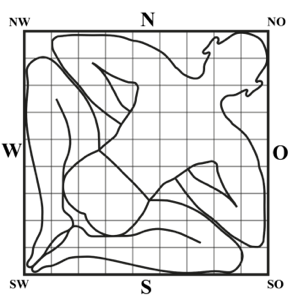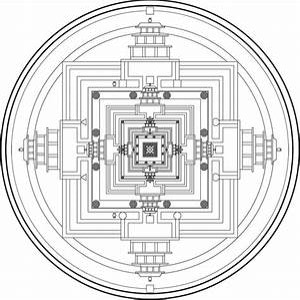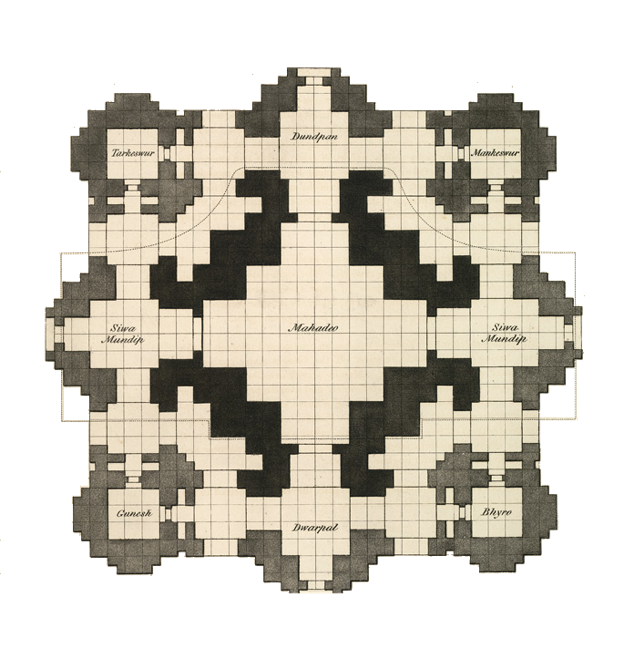II. ARCHITECTURAL COSMOGONY:
“Aedicular Expansion”

COMPARISON OF 8 X 8 AND 9 X 9-PADA MANDALAS. Bunce, Frederick J.,The Iconography of Architectural Plans, (D.K. Print World, Delhi, 2002)
VAJRAYANA MANDALA

9 X 9-PADA PARAMASAYIKA, VASTU PURUSHA MANDALA. (A paramasayika 9 x 9-pada mandala is more common in Nagara or Northern Indian architecture than an 8x8-pada manduka mandala.)

SITE PLAN, VISHVESHVARA TEMPLE, VARANASI, JAMES PRINCEP (1799-1840,) BRITISH MUSEUM

Indian and Khmer temples are the architectural expressions of a related Hindu and Buddhist cosmogony accounting for the creation of reality and its different ontological forms or modes of being. The Rigveda, consisting of 1028 hymns or incantations composed between 1500-1200 B.C.E. in northwestern India, is possibly the oldest text in any Indo-European language to come down to us, (although it was transmitted orally within the brahmin caste, where it was forbidden to be written; hence, the earliest extant manuscript dates only from c.1040 C.E.) In it, the gods dismember purusha, the Cosmic Man, to create life, the original differentiation of unity. Ymir plays this role in Norse mythology, while similar sacrificial divinities figure in the fertility myths of other cultures: Osiris in Egypt, Dumuzid in Sumeria, Adonis and Attis in Asia Minor, Nanahuatzin in Mesoamerica - perhaps Christ in Christianity. This “primal debt” has been repaid many times over–first, by human sacrifice, later, animal offerings and, finally, architectural monuments for the worship of these creator gods, like Angkor Wat.
In the Upanishads (TPQ 1000 B.C.E.,) sometimes referred to as "the last chapters" or "highest purpose" of the Vedas, purusha becomes an abstraction, Brahman, an a-theistic, dimensionless, formless, absolute, a universal spirit, self or consciousness, unknowable, but from which all else emanates, literally, ex nihilo. In the dvaita (dualistic) Shakhya schools, purusha or Brahman animates and differentiates prakriti, amorphous matter or substance; in advaita (non-dualistic) Vedanta schools, prakriti is equated with maya, phenomena, ontic or "mind-created being" and, as such, illusion, insofar as it is not seen as the projections of this non-manifest absolute. These ideas were later assimilated into Saivite and Vaisnavite Hinduism, as well as, Mahayana and Tantric Buddhism, as practiced in India and Angkor during the “Classical Period" (600-1200 C.E.) In the orthodox Shiva Siddhanta tradition, the supreme deity, Parashiva, without skalas (parts, form, differentiation) skandhas (the attributes or mental categories of "attributed being") or tattvas, "thisnesses" or qualia, manifests the universe through five aspects or pentads (analogous to hypostases and personifications:) Brahma, Vishnu, Rudra, Mahasvara and Sadashiva, oscillating continually between emission and reabsorption, creation and destruction. This is symbolized in the five-fold articulation of Shiva's originally aniconic linga into a pancha-mukha-linga, representing Sadashiva ("completed Shiva,”) and anthropomorphically, with ten arms and five head or in his twenty-eight avatars. This same ontology of emanation is represented by the primordial bindu or drop from which the universe ripples out, still commemorated by the dot many Hindus place on their foreheads every morning, as well as, by the primordial sound, the tri-syllablic A-U-M or Om, reverberating time and space or space/time down to this moment. (For a more systematic description of Indian cosmology and chronometry, see appendices I and II.)
Hinduism and Buddhism attempt to recapitulate this cosmogenesis in brick and mortar when they build their temples, one more emanation of the non-manifest “ground - (or groundlessness-) of - being.” This intimate connection between religion and architecture is inscribed in the Sanskrit distinction between a sthapaka, an architect/ priest, usually a brahmin, permitted access to the secretly transmitted Vedic texts, who designates a temple’s form, proportions and siting according to religious principles, and a sthapati, a general contractor with expertise in building, who is entrusted with materializing the sthapaka’s abstract concept. The two most widely consulted Indian architectural texts, the Vastu Shastra and Mahasara, distinguish the sthapaka as responsible for a building’s jiva, its immortal essence or energy (analogous to Brahman, purusha, the “male principle,” spirit, form and abstraction.) The sthapati's sphere, in contrast, is a temple’s prakriti (prakrti,) the physical substrate, malleable, amorphous matter, associated with the female principle and the receiver of purusha, through which the idea is given substance. This apophatic Indic deity, ironically, permitted the proliferation of voluble manifestations of this inexpressible, non-manifest oneness – avatars, gods, bodhisattvas, parallel worlds and universes, easily confused with polytheism – which could coexist with little doctrinal controversy or competition. The architectural counterpart of this multiplicity were temples of overwhelming formal complexity and visual density, in contrast with the monumentality and unity expressed pre-eminently by the dome in Mosaic monotheism’s churches and mosques, a form unknown in pre-Islamic (1092) India and to the Khmer. This in no way contradicted Hindu and Buddhist epistemology, since these monuments, their shrines and the deities who inhabited them were ultimately illusions or maya, “dependently originated” from the dimensionless “non-manifest.” Enlightenment, satori, and salvation, moksha or nirvana, came with the realization of one’s own and the world’s sunyata or emptiness; in the words of the Heart Sutra, “form is emptiness, emptiness form,” certainly, a paradoxical foundation on which to build an architecture.
The Vastu Purusha Mandala
One way sthapakas re-enacted creation by emanation was by constructing their temples out of aedicules – small buildings, shrines, simulacra or replica of the structures of which they formed a part, in other words, buildings built of buildings. In his path-breaking studies, Indian Temple Architecture: Form and Transformation (Indira Gandhi Center for the Arts, New Delhi, 1995) andThe Temple Architecture of India (Wiley, Hoboken NJ, 2008,) Adam Hardy describes this method of generating architectural space as “aedicular expansion,” not just the use of an Albertian grid or Corbusian modular but the replication of a repertory of shrine types each with its celestial tenant. The first-time visitor to Khajuraho, Halebidu or Madurai is often struck by a superabundance, bordering on optical overload, which threatens to vitiate the coherence and solidity of the structures they comprise. These temples’ matrix of multiple rathas, latas or pagas (vertical facets, projections, corners or angles) and pidas, bhumis or talas (horizontal stories, levels or tiers) can result in an initially “jittery” or pulsating impression, a sense of motion rarely encountered in architecture, a prolixity rarely indulged to the point where it drowns out its own utterance, because, in the end, all words are echoes of each other, and of the A-U-M.
The Vastu Shastra, the Indian equivalent of Vitruvius, Serlio and Palladio in the West, except with divine sanction, provides precise directions for a temple’s spatial projection based on a revised version of the creation myth of the purusha or Cosmic Man. Brahma (the creator god, not to be confused with Brahman or brahmins) conceived a primitive giant, the vastu purusha, whose, unrestrained (“male”) libido wreaked chaos and disorganization over the passive, (“female”) earth. He therefore ordered the other gods, men and demons to confine this untamed, literally undomesticated, “wild man” within a domicile, an ordered square, a built space. This is the perfect or ideal shape in Hinduism because of its orthogonal, four-fold symmetry, in contrast with biomorphic, formless prakriti which needs to be ruled - both measured and dominated. The vastu purusha was so powerful he had to be pinned down in a grid of 8 x 8 or sixty-four squares or padas. Brahma held him in the middle four, the gods in the surrounding twelve, humans in the twenty beyond those and the demons in the outer twenty-eight. The myth conflates an unusual combination of familiar topoi: (a) the purusha’s dismemberment, the primal fall from unity into multiplicity; (b) Freud’s sublimation of libidinous energy to the “demands of reality” and social life; (c) patriarchal domination of inchoate, “female” physicality by “male” rationality; (d) the “civilization” of untamed space or wilderness by an architectural regime. The vastu purusha or manduka mandala became the prototype for all the other architectural mandalas or grids regulating the “aedicular expansion” of Hindu and Buddhist temples, private houses and even cities, all theoretically emanating from a single dimensionless point, where the planar axes cross. The Vastu Shastra alone lists thirty-one other mandalas, ranging from a single square to a 32 x 32 or 1024-pada (210) grid, including circular mandalas and combinations of the two.